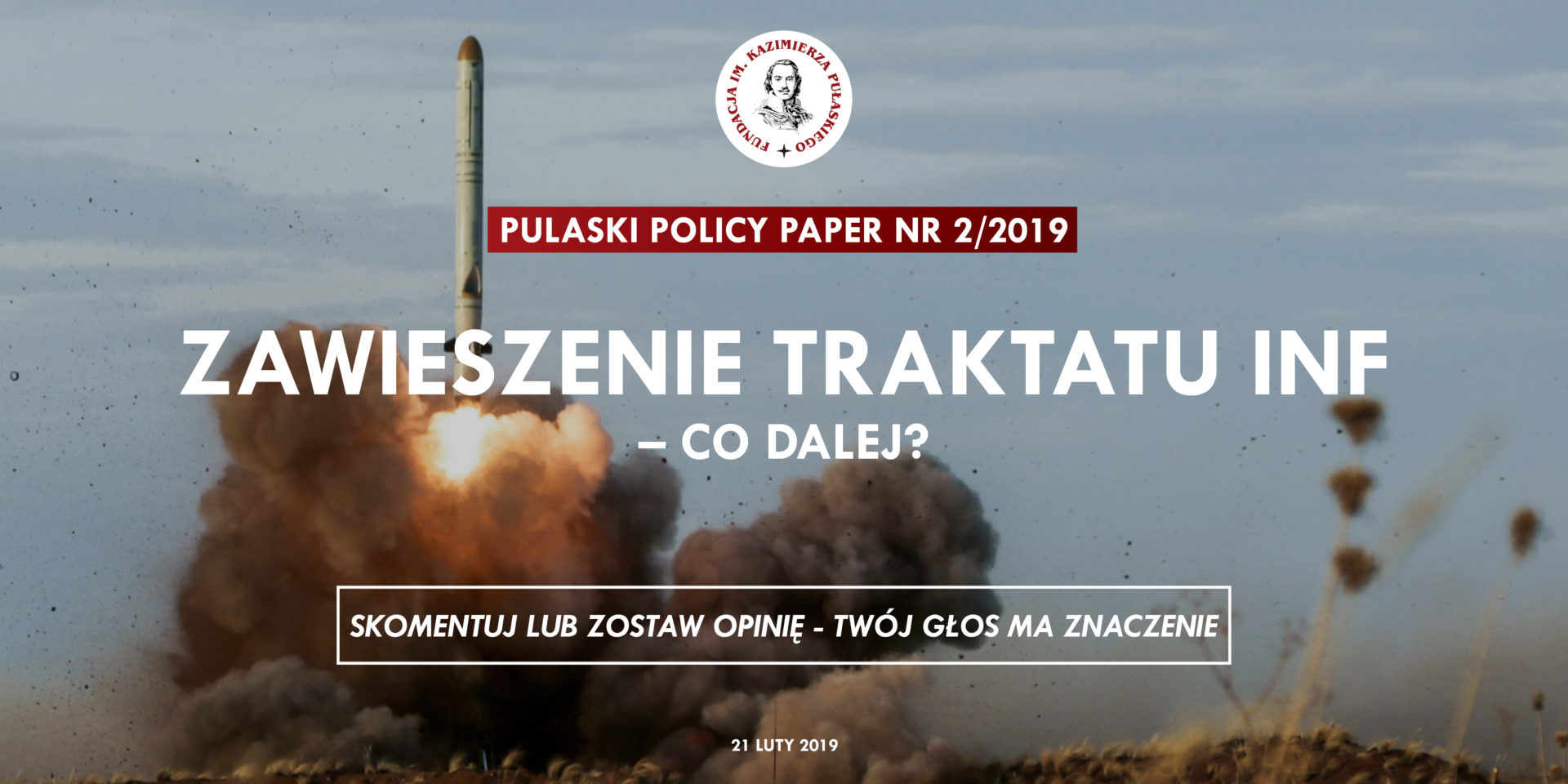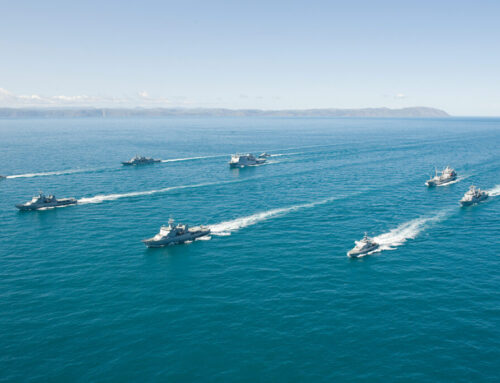PULASKI POLICY PAPER – T.J. Omedi: Suspension of the INF Treaty – What’s next?
Autor foto: Domena publiczna

Suspension of the INF Treaty – What’s next?
February 21, 2019
Author: Thomas Jura Omedi



PULASKI POLICY PAPER – T.J. Omedi: Suspension of the INF Treaty – What’s next?
Autor foto: Domena publiczna
Suspension of the INF Treaty – What’s next?
Author: Thomas Jura Omedi
Published: February 21, 2019
Pułaski Policy Paper No 2, 21 February 2019
The Russian Ministry of Foreign Affairs announced that on February 2nd, 2019 the U.S. Department of State sent an official notice declaring a U.S. suspension of the Intermediate-Range Nuclear Forces Treaty (INF). This decision is a follow-up of Donald Trump’s threats to withdraw from the bilateral agreement between the Russian Federation and the United States which banned land-based cruise and ballistic missiles with ranges of 500–5,500 km. The final U.S. withdrawal should take place in six months. According to Donald Trump’s administration, Russia has violated the treaty by producing and deploying the 9M729 (SSC-8) missiles. The U.S. decision has been supported by NATO member states; furthermore, the Secretary General of the Alliance Jens Stoltenberg emphasized that “all Allies have concluded that Russia has developed and fielded a new ground launched cruise missile system. The SSC-8, also known as the 9M729. Allies agree that this missile system violates the INF Treaty and poses significant risks to Euro-Atlantic security.”[i] The Russian Federation has denied the U.S. accusations claiming that the United States started another arms race. In retaliation, Moscow has also suspended its compliance with the INF Treaty. During a televised meeting, the President of the Russian Federation Vladimir Putin accepted a suggestion of the Minister of Defence, Sergei Shoigu, to develop a land-based platform for the Kalibr cruise missiles as well as a new hypersonic intermediate-range missile.[ii] However, it is worth noting that the mentioned land-based Kalibr missile is apparently the same type of missile as the 9M729, which is currently under development.
Western perspective on American and European Security
In the 2019 State of the Union Address, President Trump announced that despite the United States followed the agreement with the Russian Federation, the latter had been violating the treaty for several years. In 2008, the press informed that the Russian Federation tested cruise missiles that violated terms of the treaty. In 2013, the Under Secretary of State for Arms Control and International Security Affairs, Rose Gottenmoeler, suggested that Russia had allegedly violated the INF treaty. In 2014, President Obama’s administration sent an official request to the Russian Federation to discuss the agreement on arms control.[iii] The 2015 report of the Department of State summarised U.S. accusations against Moscow.[iv]
According to the Secretary of State, Michael Pompeo, “the INF Treaty is no longer effective due to Russia’s ongoing material breach. Today’s actions are to defend U.S. national security and interests and those of our allies and partners.”[v] From the U.S. perspective, the missiles banned by the INF Treaty are perceived as a direct threat to the U.S. territory. Given the deployment of the intermediate-range missiles in the Russian Far East, the entire West Coast and the Central States (including Iowa) would be within range of Russia’s land-based missiles. However, the 1987 INF Treaty has been particularly important in the European context. The Treaty prevented both the United States and the Soviet Union from deploying the Pershing II and the RSD-10 Pioneer ballistic missiles respectively. The German Minister of Foreign Affairs, Heiko Mass, expressed deep concern about the current situation and stated that the Treaty was “an important pillar of our European security architecture.”[vi]
It seems certain that the U.S. suspension of the INF Treaty has not been officially consulted with the NATO member states. In late 2018, the Secretary of Defense James Mattis warned defence ministers of NATO members that the Treaty “would no longer be tenable” if Russia does not stop violating its terms.[vii] To reassure Washington’s allies regarding the U.S. stance, Mattis also emphasised that the U.S. administration would struggle to preserve the Treaty.[viii] However, his speech was not in line with the opinion expressed by the U.S. National Security Advisor John Bolton who announced that the United States would withdraw from the agreement with the Russian Federation.[ix] Moreover, in late 2018, President Trump said that the situation in which the United States is the only side following the terms of Treaty is unacceptable. On the other hand, Trump suggested that the Treaty could be preserved in an extended format involving other countries, such as China.[x] Undoubtedly, John Bolton has been one of the strongest supporters of the U.S. suspension of the INF Treaty. Prior to his appointment as U.S. National Security Advisor, Bolton repeatedly emphasized that the INF “has become obsolete” and “it should have been modified or suspended”.[xi] Nevertheless, the U.S. administration attempted to negotiate this matter with the Russian Federation and encouraged Moscow to abandon projects that violated the Treaty.
Russian violation of the INF Treaty–Novator 9M729
The destabilizing role of short-range and intermediate-range missiles was one of the reasons why the United States and the Soviet Union decided to sign the INF Treaty and subsequently ban such weapons. Given a relatively short flight time of these missiles and their capability to carry nuclear warheads, the defence against this type of threats or even their detection is an extremely difficult task for early-warning systems. In 2014, Barack Obama’s administration accused Russia of developing missiles banned by the Treaty. The 9M279 cruise missiles produced by the Russian company Novator was likely the main concern of the U.S. officials at the time, despite the development of other suspicious missile systems by the Russian Federation. The 9M279 is probably the latest variant of the surface-to-surface Iskander-K 9M278 cruise missile (SSC-7).[xii] The Iskander-K equipped with electro-optical guidance system for self-homing capability has an official range up to 500 km and can reach altitude of 6 km. This is why Moscow claims that the Iskander-K 9M278 does not violate the INF Treaty. However, Western analysts believe that the 9M279 is actually a land-based variant of another Russian missile 3M14 (SS-N-30). The latter one is a surface ship- and submarine-launched cruise missile operated by the Russian Navy in several different variants which are part of the Kalibr missile family.[xiii]
In December 2015, Russia used this type of missiles in combat against the Syrian Opposition Forces. The 9M279 has an estimated range of 1,500-2,500 km which seems to be true given that the Russian Navy launched missile strikes against targets in Syria from the Caspian Sea, about 1,800 km away. If the 9M279 is indeed a modified land-based variant of the 3M14 deployed on Iskander missile launchers, it would mean that the very existence of the 9M279 missile is violating the terms of the INF Treaty. Such a hypothesis is supported by a very close physical resemblance between the two missiles. Based on released pictures of the 9M279, it is very difficult to answer the question of whether the two missiles are actually the same; however, there are certain obvious similarities between them such as position of wings and the overall height of these missiles.[xiv]
Given the press conference organized after the NATO-Russia summit on January 25, 2019 by the General Secretary of NATO Jens Stoltenberg, it seems certain that the 9M279 was a missile that triggered Obama’s administration to accuse the Russian Federation of violating the INF Treaty. It is also worth noting that the 9M279 was also mentioned in the final declaration of the 2018 NATO Summit in Brussels. Stoltenberg emphasised that all NATO member states agree that the 9M279 does violate the Treaty. The unanimous stance of the Alliance forces Russia to admit the very existence of the 9M279. In response, the Ministry of Defence of the Russian Federation published a picture of U.S. missiles that allegedly violated the Treaty as well (in fact, the picture showed a missile testing facility of a U.S. defence company in Arizona). The Russian Ministry of Defense did not specify which missile could theoretically violate the U.S.-Russia agreement.[xv] On the other hand, Russia publicly displayed the 9M279 despite that the very existence of the missile had been denied prior to the latest tension between Washington and Moscow.[xvi] Russian officials assured that the missile could be examined by NATO emissaries even though such a visit could not assess the combat performance of the missile. The U.S. Under Secretary of State for Arms Control and International Security Affairs Andrea L. Thompson pointed out this matter and subsequently rejected Russian proposal.
The Post-INF World–China, North Korea, United States, and Russia
The INF Treaty provided both sides of the agreement with certain limited benefits and this fact is a key to understand the implications of its suspension. The Treaty comprised only the two nations even though both the Russian and U.S. administration were aware of China’s development of advanced weapon systems. The United States is continuing to lose ground to China as a result of the latter’s heavy investment in military technologies. It is worth noting that a large portion of Chinese missile systems would have been banned if China had joined the U.S.-Russia agreement. The DF-26 intermediate-range ballistic missile (range up to 5,500 km) is one of the latest Chinese weapons perceived as a threat to the U.S. territory. These missiles were even dubbed ‘Guam Killers’ due to their capability to strike American bases on Guam. Prior to his appointment as the U.S. National Security Advisor, John Bolton suggested that a lack of land-based intermediate-range cruise missiles would not be necessary to counter Russian military in the case of an armed conflict. According to Bolton, however, the missiles banned by the INF Treaty are absolutely indispensable to balance the growing potential of the Chinese Armed Forces.[xvii] The 2018 report of the Department of Defense entitled ‘Military and Security Developments Involving the People’s Republic of China 2018’ also highlighted China’s advances in missile technology particularly in terms of cruise missiles. In the report, the U.S. military officials stated that current capabilities of the Chinese Armed Forces may disrupt U.S. military operations in the region by preventing American naval vessel from approaching the coast.[xviii] In 2017, the Commander of United States Indo-Pacific Command Harry Harris argued that the U.S.-Russia agreement should be renegotiated due to its limitations on U.S. missile defence capabilities against China’s land-based ballistic and cruise missile systems. The Russians also addressed this matter and pointed out that the Treaty in its current shape leads to imbalance between China and the two sides of the agreement. Chinese officials are apparently not interested in joining the INF Treaty or signing another bilateral agreement with the United States or the Russian Federation. Another problem with the INF Treaty is that the agreement does not involve North Korea and Iran.
It is also worth noting that the United States has changed its perception of the Russian Federation. In January 2019, the Department of Defense published another report entitled ‘Missile Defense Review 2019’ that named Russia a revisionist state and a threat to Western democracies that could even conduct a pre-emptive nuclear strike.[xix] The previous 2010 report sent a completely different message by mentioning the Russian Federation as a potential partner in developing common missile defence.[xx] Nevertheless, the latest report of the Department of Defense addressed also other important issues; for example, the significance of counteroffensive operations that could eliminate hostile missiles on the ground. The paper suggests that the United States will use the suspension of the INF Treaty to develop missiles that have been previously banned by the agreement. It is certain that the Russian Federation will develop and introduce further missile systems including the 9M279 and a new hypersonic intermediate-range missile. However, it is worth noting that the Russian militarization has not triggered the United States to deploy new land-based missiles in Europe.
Conclusions
1. Preserving the INF Treaty by both signatories of the agreement was a difficult task in the long run. Neither the Russian Federation nor the United States perceived the Treaty as beneficial given its limitations on military capabilities of the two countries. Russia has been violating the Treaty for many years that led to a situation in which the United States was the only side of the agreement following its terms.
2. It is highly unlikely that the United States and Russia will be able to reach a compromise and sign another agreement replacing the INF Treaty. Russia has suspended the implementation of the Treaty in retaliation for the U.S. suspension of the agreement. Then, the Russian officials publicly announced development of new hypersonic missiles as well as the land-based variant of the Kalibr missile despite the fact that such a missile has already been under development for several years.
3. Undoubtedly, the Russian administration is responsible for triggering diplomatic tensions related to the INF Treaty. The very existence of the 9M279 missile is violating the terms of the INF Treaty given that the missile derives from the 3M14 which has a range of 1,500-2,500 km. The latest information from the Russian Ministry of Defense confirmed the assumptions that the 9M279 was the missile that violated the agreement with the United States. On the other hand, the Russian Federation has no evidence that the United Stated has been developing a similar type of missile.
4. The German and Swedish ministers of foreign affairs expressed a lot of concerns about the future of the European security architecture which has been based on the INF Treaty. Russia’s suspension of the agreement means that the Western European nations will be also within range of Russian land-based missiles.
Author: Thomas Jura Omedi, Fundacja im. Kazimierza Pułaskiego
[i] “Press conference by NATO Secretary General Jens Stoltenberg following the meeting of the North Atlantic Council in Foreign Ministers’ session”, NATO, December 4, 2018 https://www.nato.int/cps/en/natohq/opinions_161110.htm
[ii] “Meeting with Sergei Lavrov and Sergei Shoigu”, President of Russia, February 2, 2019 http://en.kremlin.ru/events/president/news/59763
[iii] Michael R. Gordon, “U.S. Says Russia Tested Cruise Missile, Violating Treaty“, The New York Times, July 28, 2014 https://www.nytimes.com/2014/07/29/world/europe/us-says-russia-tested-cruise-missile-in-violation-of-treaty.html
[iv] “2015 Report on Adherence to and Compliance With Arms Control, Nonproliferation, and Disarmament Agreements and Commitments”, U.S. Department of State, June 5, 2015 https://www.state.gov/t/avc/rls/rpt/2015/243224.htm#INF2
[v] “U.S. Intends To Withdraw from the INF Treaty February 2”, US Mission to International Oragnizations in Geneva, February 2, 2019 https://geneva.usmission.gov/2019/02/04/u-s-intent-to-withdraw-from-the-inf-treaty-february-2-2019/
[vi] Alex Ward, “The US is withdrawing from a nuclear arms treaty with Russia. An arms race might be next”, Vox, February 5, 2019 https://www.vox.com/2019/2/1/18206619/inf-treaty-usa-russia-pompeo-trump
[vii] Julian Borger, Martin Pengelly, “Trump says US will withdraw from nuclear arms treaty with Russia”, The Guardian, October 21, 2018 https://www.theguardian.com/world/2018/oct/20/trump-us-nuclear-arms-treaty-russia
[viii] Idrees Ali, “Mattis looks to calm European allies nervous about INF treaty”, Reuters, October 28, 2018 https://www.reuters.com/article/us-usa-nuclear-mattis/mattis-looks-to-calm-european-allies-nervous-about-inf-treaty-idUSKCN1N20C0
[ix] Andrew Roth, “US confirms withdrawal from nuclear arms treaty with Russia”, The Guradian, October 23, 2018 https://www.theguardian.com/world/2018/oct/23/bolton-inf-treaty-russia-putin-moscow-meeting
[x] Adam Taylor, “How China plays into Trump’s decision to pull out of INF treaty with Russia”, The Washington Post, October 23, 2018 https://www.washingtonpost.com/world/2018/10/23/how-china-plays-into-trumps-decision-pull-out-inf-treaty-with-russia/?utm_term=.9dfa2e35474b
[xi] John Bolton, John Yoo, “An Obsolete Nuclear Treaty Even Before Russia Cheated”, The Wall Street Journal, September 9, 2014 https://www.wsj.com/articles/john-bolton-and-john-yoo-an-obsolete-nuclear-treaty-even-before-russia-cheated-1410304847
[xii] Jeffrey Lewis, “Russian cruise missiles revisited”, Arms Control Wonk, October 27, 2015 https://www.armscontrolwonk.com/archive/207816/russian-cruise-missiles-revisited/
[xiii] Missile Defense Project, „SS-N-30A (3M-14 Kalibr)”, Missile Threat, Center for Strategic and International Studies, August 11, 2016 https://missilethreat.csis.org/missile/ss-n-30a/
[xiv] Jeffrey Lewis, “Russian cruise missiles revisited”, Arms Control Wonk, October 27, 2015 https://www.armscontrolwonk.com/archive/207816/russian-cruise-missiles-revisited/
[xv] “US started production of intermediate-range missiles two years before it accused Russia of violating the INF Treaty”, Ministry of Defence of the Russian Federation, February 2, 2019 http://eng.mil.ru/en/news_page/country/more.htm?id=12215542@egNews
[xvi] Neil MacFarquhar, “Russia Shows Off New Cruise Missile and Says It Abides by Landmark Treaty”, The New York Times, January 23, 2019 https://www.nytimes.com/2019/01/23/world/europe/russia-inf-cruise-missile.html
[xvii] John Bolton, John Yoo, “An Obsolete Nuclear Treaty Even Before Russia Cheated”, The Wall Street Journal, September 9, 2014 https://www.wsj.com/articles/john-bolton-and-john-yoo-an-obsolete-nuclear-treaty-even-before-russia-cheated-1410304847
[xviii] “Military and Security Developments Involving the People’s Republic of China 2018”, U.S. Department of Defense, May 16, 2018 https://media.defense.gov/2018/Aug/16/2001955282/-1/-1/1/2018-CHINA-MILITARY-POWER-REPORT.PDF
[xix] “Missile Defense Review 2019”, U.S. Department of Defense, January 17, 2019 https://media.defense.gov/2019/Jan/17/2002080666/-1/-1/1/2019-MISSILE-DEFENSE-REVIEW.PDF
[xx] Jackie Mahler, Donald N. Jensen, “After the inf treaty, what’s next?”, Center for European Policy Analysis, February 1, 2019 https://www.cepa.org/after-the-inf-treaty-whats-next





